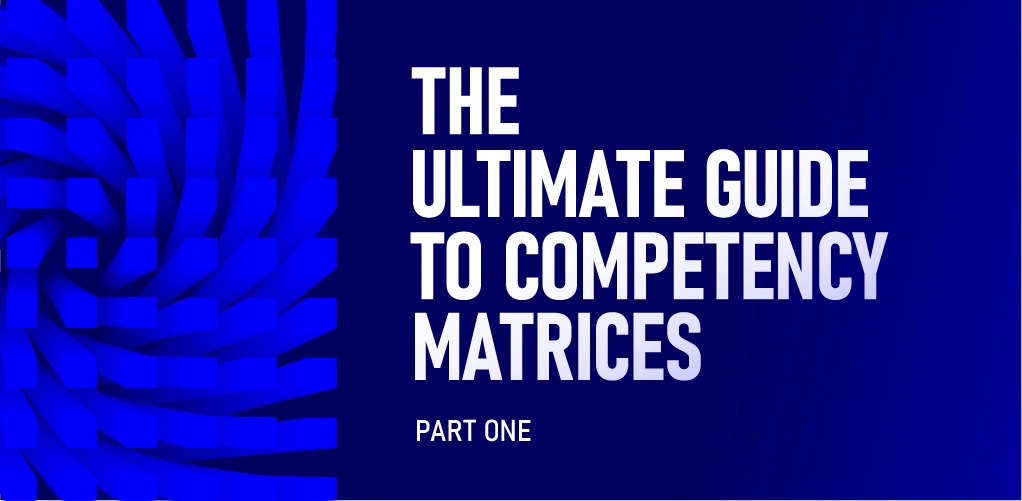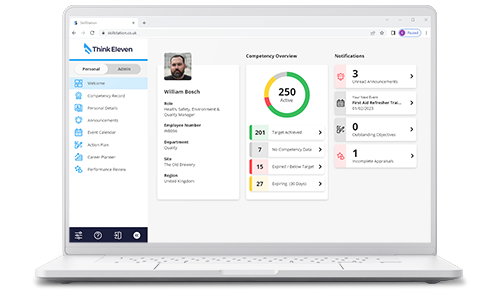This is the first of a two part article, aiming to provide a complete guide on how competency matrices can transform workforce management. We will be Defining what a competency matrix is and how it works. Highlighting the differences between skills and competencies. Explaining how competency and skills matrices help close skill and training gaps as well as understanding how these are useful tools to drive forward the objectives of the organisation.
What This Guide Covers
This 2-part article aims to provide a complete guide on how competency matrices can transform workforce management by:
- Defining what a competency matrix is and how it works.
- Highlighting the differences between skills and competencies.
- Explaining how competency and skills matrices help close skill and knowledge gaps.
- Providing actionable strategies to incorporate training and development.
- Demonstrating how to align roles and responsibilities with organisational goals.
- Discussing proficiency levels and their role in effective assessment methods.
- Exploring the use of skills management tools to optimise workforce planning.
Whether you are looking to improve team performance, address skill gaps, or streamline training programs, this guide will provide valuable insights and practical applications.
Unleashing Performance: The Power of Competency Management
To stay competitive organisations need to be laser focused on their organisational goals. One approach to achieving this is to ensure that the relevant skills and competencies are available within the workforce. Organisations also need to be able to effectively understand existing strengths and weaknesses within the workforce, how this will affect future requirements and in turn informing the next cycle of training and development initiatives. To achieve this an organisation needs to use an approach of competency management, incorporating multiple processes, tools and techniques e.g. developing a competency framework. In this guide, we will be focusing on one such tool: the competency matrix
A competency matrix helps businesses organise and assess employee skills and strengths, making it easier to identify gaps, address weaknesses, and align efforts with organisational objectives. With the right strategy, it can transform talent management, enhance team performance, develop organisational resilience and align workforce capabilities with business goals.
This guide explains what competency matrices are, how they work, and why they’re so effective. We’ll provide practical examples, use cases, and strategies to maximise their impact. No matter the size of your organisation, competency matrices can unlock workforce potential and drive long-term success.
If you’re looking to make smarter decisions, engage employees, and align skills with goals, competency matrices are the solution. Read on to discover how this tool can elevate your team and improve business outcomes.
What is a Competency / Skills Matrix?
The terms skills matrix and competency matrix are related but not entirely interchangeable, as they have distinct focuses:
- Skills Matrix: Primarily focuses on specific, measurable skills that employees possess or need to develop. It’s often task-oriented, listing individual skills required for particular roles or projects. Skills matrices are frequently used to address gaps in technical or hard skills.
- Competency Matrix: Takes a broader approach by including not only specific skills but also knowledge, behaviours, and wider attributes required for success in a role or organisation. Competency matrices often align more closely with organisational goals and strategic workforce development.
While they are sometimes used interchangeably in casual conversation, it’s important to distinguish them when precision is required. If your context involves a mix of technical skills and behavioural or strategic competencies, the term competency matrix would be more accurate. For a purely task- or skill-focused approach, skills matrix is more appropriate.
How is a Competency Matrix Used in an Organisation?
Competency matrices offer numerous practical applications that make them an indispensable tool for workforce management. Here are some ways competency matrices are utilised:
- Finding Skill Gaps: They make it easier to see where employees need to improve or learn new skills, helping to target training programs where they’re needed most.
- Planning Resources: Managers can use them to assign the right/best people to the right tasks or projects, ensuring that each role is filled by someone with the necessary expertise.
- Tracking Performance: Compare what available skills employees have to what skills they need to do their jobs well. Monitor individual development and team performance over time to ensure continuous improvement and alignment with organisational goals.
- Preparing for the Future: Identify employee potential and help them grow into future roles, ensuring a strong pipeline of talent for succession planning and organisational resilience.
Benefits of Competency Matrices
- Provide a structured overview of required skills, knowledge, and behaviours for specific roles.
- Identify skill and competency gaps, enabling informed future training opportunities, recruitment, and resource allocation.
- Enhance employee development by clarifying expectations and career progression opportunities.
- Support workforce planning by ensuring the right people are in the right roles.
- Boost productivity and improve overall organisational performance.
Example Project Cases:
Example 1: A software development team uses a competency matrix to identify members proficiency in programming, project management, or testing. This helps the manager assign tasks, build the right team, and plan training if needed. For instance, a tester needing coding support can receive training, ensuring a smoother, more successful project that meets its goals. A competency matrix can also incorporate broader competencies or soft skills, like problem-solving and collaboration.
Example 2: A logistics organisation with 4,500 employees across seven sites has to carry out an annual Training Needs Analysis (TNA) to establish the development needs in order to close gaps. This was previously carried out by the Group L&D Manager collating all of the fragmented Training/Skills Matrices from across the business and then producing a TNA, which took six-weeks. Since the adoption and implementation of both a Competency Matrix (framework) and a fit for purpose Competency Management System (CMS), the TNA is now produced in six mouse clicks!
Skills vs. Competencies: What’s the Difference?
Though often used interchangeably, “skills” and “competencies” have distinct meanings:
What are Skills?
Skills are specific abilities gained through practice, training or education. They are measurable and directly applicable to tasks or roles, such as coding, operating machinery, or analysing data.
Skills fall into two categories:
- Hard skills: Job-specific and measurable, like accounting or graphic design.
- Soft skills: Interpersonal and transferable, like communication, teamwork, or adaptability.
Hard skills are essential for performing tasks, while soft skills are crucial for navigating challenges and fostering collaboration. Both are critical for short-term success but must be complemented by a foundation of competencies for long-term growth.
What are Competencies?
Competencies are a combination of knowledge, skills, abilities, and behaviours needed to perform a role effectively. Unlike skills, competencies focus on how tasks are performed, not just what is done.
Key elements of competencies include:
- Knowledge: Subject expertise (e.g., safety regulations, industry trends, qualifications).
- Skills: Specific abilities (e.g., project management).
- Abilities: Aptitudes or developed capabilities (e.g., leadership, critical thinking, problem solving).
- Behaviours: Ways of working (e.g. adaptability, conscientiousness).
Competencies align individual performance with organisational values and goals, ensuring employees not only meet technical requirements but also contribute to cultural and strategic objectives.
By focusing on competencies, organisations can build an optimised workforce that is skilled, adaptable, and prepared for long-term success.
The Role of Technology in Competency Matrices
Technology can play a critical role in the successful implementation and management of competency and performance management. Advanced tools like Skills Management Software / Competency Management Software streamline the process of tracking, updating, and analysing competencies across the workforce. SkillStation for example, helps organisations monitor current skill levels, identify gaps, and plan targeted development programs and career pathways.
Benefits of Technology in Competency Matrices
- Real-Time Updates: With technology, competency and skills matrices can be generated and updated instantly, ensuring accuracy and relevance.
- Data-Driven Decisions: Software tools, such as SkillStation, provide detailed analytics (e.g. a skills matrix), helping organisations identify actual capability, report on trends, assess performance, and make informed decisions about workforce planning.
- Streamlined Assessments: The right competency management systems (CMS) provide a suite of assessment methods, enhanced by automation technology and facilitating easy self-assessment. It can also capture in-person, physical evaluations (e.g. a Line Manager assessment). Reporting on these assessments is easier, saves time and helps to improve consistency.
- Scalability: Digital platforms enable organisations to manage competency matrices for teams of any size, from small departments to a global workforce. A list of core competencies or an effective skills matrix is usually only a few clicks away.
By leveraging technology, organisations can unlock the full potential of competency matrices, making them more actionable, impactful and drive organizational goals.
Combining a Competency Matrix with Training to Close Skill Gaps
Skill gaps are one of the biggest challenges organisations face when trying to improve workforce performance. Efficient identification of these gaps mean they can be addressed swiftly through targeted training programs.
Addressing Knowledge Gaps
Customised Learning Plans: Competency matrices make it easy to identify specific skill gaps and design training programs tailored to individual or team, or functional needs.
Continuous Development: By regularly tracking progress, organisations can ensure ongoing growth and adaptation to new challenges.
Measuring Impact: Training can be linked to the improvement of skill levels as documented in the competency matrix, ensuring that development efforts are effective and deliver tangible benefits.
The Role of Competency Matrices in Training
Competency matrices enhance training programmes by identifying the specific technical skills required for different roles, highlighting broader skill set development, and aligning training efforts with organisational objectives.
Defining Roles Through Competency Matrices
Competency matrices not only assess employees’ abilities but also help define the specific competencies required for specific roles. Mapping these competencies ensures role expectations are clear and aligned with organisational goals—a practice known as a competency framework.
Benefits of Defining Roles
Improved Hiring: Use competency matrices to define the skills and knowledge required for new hires, streamlining the recruitment process.
Role Clarity: Employees better understand their responsibilities and expectations when roles are clearly defined through a competency-based framework.
Effective Management: Managers can use the matrices to allocate tasks based on employee strengths and proficiency.
Competency matrices make it easier for organisations to align roles with long-term goals, ensuring that every employee contributes effectively to the team’s success.
Understanding Proficiency Levels in Competency Matrices
Proficiency levels are a key element of any effective competency matrix. They allow organisations to measure how well employees perform specific skills or demonstrate core competencies. By categorising proficiency, organisations gain deeper insights into employee strengths, skill gaps, and areas for growth.
What Are Proficiency Levels?
Proficiency levels describe the degree to which an individual can perform a task or demonstrate a competency. They often range from beginner to expert and provide a structured way to evaluate performance. Commonly used levels include:
Foundation: Basic understanding and limited application of the skill or competency.
Intermediate: Ability to perform tasks with some supervision or support.
Advanced: High level of independence and consistency in applying the skill or competency.
Expert: Mastery and the ability to guide or train others in the skill or competency.
Different Competencies, Different Proficiency Levels
It’s worth remembering that not one size fits all when defining a proficiency level structure. Technical competencies may use the structure from the example above, but compliance-based competencies may use something binary, like Pass or Fail. It's important that when defining the competency framework that these proficiency levels are given thorough consideration to ensure relevance of outcome.
Why Are Proficiency Levels Important?
Proficiency levels are essential in ensuring that organisations maximise the effectiveness of their workforce. They provide a structured way to:
- Identify Skill Gaps: Determine where employees need additional training or support, enabling targeted and effective interventions.
- Track Growth: Monitor progress over time as employees develop their skills and competencies, ensuring continuous improvement.
- Customise Training: Tailor learning and development programs to meet specific proficiency needs, enhancing the relevance and impact of training.
- Support Core Competencies: Ensure employees consistently meet the behavioural and technical expectations required for their roles, aligning individual performance with organisational goals.
Incorporating Proficiency Levels into Competency Matrices
Adding proficiency levels to a competency matrix enhances its effectiveness. For each core competency or skill, organisations can assign a proficiency level to employees, making it easier to identify where additional resources or support are needed. For example, if a core competency like leadership is marked at an intermediate level for a team member, targeted training can help them advance to an expert level.
Proficiency levels also make competency matrices more actionable by highlighting patterns across teams or departments, allowing leaders to address broader workforce development needs. Team leaders can use these matrices to plan professional development plans tailored to their team’s needs.
Integrating Capability Matrices
While competency matrices focus on individual skills and behaviours, a capability matrix examines the overall abilities of a team or department. Capability matrices help organisations assess collective strengths, identify team skill gaps, and ensure that teams are prepared to tackle upcoming challenges. When used alongside competency matrices, capability matrices provide a comprehensive view of both individual and team capabilities and capacity, enabling more strategic workforce planning.
Enhancing Employee Engagement
This structured approach to employee competencies is a great way to positively engage with the workforce.
- Foster Growth Opportunities: Easily show relevant competencies to employees for clear paths of development, increasing motivation and job satisfaction.
- Promote Collaboration: Highlight team strengths, encouraging employees to work together and leverage each other’s expertise.
- Increase Retention: Engaged employees are more likely to remain loyal, reducing turnover and building a stable workforce.
For example, when employees see how their contributions align with broader team goals through a capability matrix, they feel more connected to the organisation’s success.
Maximising Workforce Potential: The Power of a Competency Matrix
As we've covered in this article, Competency matrices are powerful tools that help organisations make the most of their employees’ abilities. They show where skill gaps exist, highlight strengths, and align individual growth with organisational goals. By understanding and using competency matrices, businesses can boost performance, improve talent management, and build stronger teams.
We hope this guide has explained what competency matrices are, how they’re used, and why they’re so important. By applying these insights, organisations can unlock their team’s potential and make sure every employee contributes to success. The result is a more efficient, engaged, and capable workforce that drives organisational performance and growth.
What’s Next?
In the second part of this article, we’ll cover how to create and implement a competency matrix. Topics will include:
- Responsibility and Accountability: We will define who within your organisation is best placed to create, review and develop your Competency Matrices (framework) and review its suitability and utilisation.
- Building an Effective Competency Matrix: Learn about the key parts, like roles, skills, and rating systems.
- Best Times to Use a Competency Matrix: See how matrices help in hiring, training, and performance reviews.
- Assessment Methods: Understand how to evaluate competencies effectively.
Stay tuned for Part 2 to learn how to create a competency matrix that works for your team and your goals!


